- 12 minute read
- Business Management Tips
- Local Strategies
- SEO
Beginner,
Intermediate
Get a behind-the-scenes-look into FareHarbor's 2024 season
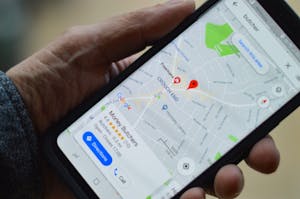
As a business owner, your main goal related to your online presence is for customers to find you and book with your company. Google Business Profile is a vital tool for reaching that goal, helping searchers find and get to know your business right on the search engine results pages (SERPs). This free tool allows you to manage your online presence across Google’s various features and platforms.
Free and easy to use, setting up and maintaining your Google Business Profile has huge benefits when it comes to local SEO. Your Business Profile information can determine how customers find you and interact with you, making it a crucial tool that business owners can’t afford to ignore. This guide provides an overview of what Google Business Profile is and how it can help your business.
Google Business Profile is a listing that displays your company’s information, such as location, contact information, and user reviews, across various Google features and platforms. Your account allows you to ensure that customers are getting the most detailed, accurate information about your business when they encounter you in online searches.
While it’s completely free to use, it can be invaluable to your online strategy. The information that you input to Google Business Profile is reflected in local SEO searches, Google Maps searches, and more. Ensuring that this information is accurate and thorough helps your chances of ranking at the top. It also signals to users that yours is a legitimate, established business that they can trust.
Your profile is especially important in terms of your local SEO strategy. It helps your business rise to the top of local searches and ensures that potential customers feel confident in booking with you because they can easily access information about your business.
In short, every business needs a Google Business Profile because:
One of the great things about Google Business Profile is that you only have to enter all your business information once and it appears across multiple Google features and platforms. The following three Google features are the most important and useful for your business.
 When you do a local search like “kayak rentals near me,” the SERP feature you see at the top of the search results is the Local Map Pack. It displays a map of the city, with pins showing the location of the nearby businesses, followed by the top three businesses that match your search, with the option to expand the list.
When you do a local search like “kayak rentals near me,” the SERP feature you see at the top of the search results is the Local Map Pack. It displays a map of the city, with pins showing the location of the nearby businesses, followed by the top three businesses that match your search, with the option to expand the list.
These search results display contact information, hours of operation, and user reviews, which are crucial factors that a searcher considers when selecting a local business. The Local Map Pack is especially important for mobile searches. When travelers are searching for a tour or activity in the city they’re visiting, they’re likely to do local searches on their phone, and the Local Map Pack can put your business front and center and makes it easy for them to book with you fast.
The Knowledge Graph appears in branded searches (when you search for a business by its name), and it’s the box near the top in mobile searches and in the top right-hand corner on desktop. This box displays your business’ location on the map, photos submitted by you or people who have reviewed your business, along with NAP data (name, address, phone), hours of operation, reviews, questions and answers, and more. (The Knowledge Graph has other uses unrelated to businesses, but we won’t get into those here.) You can even highlight products (tours and activities) right on the Google Business Profile listing that shows up in the Knowledge Graph, allowing customers to view more details about your offerings and click through to your website to make a booking.

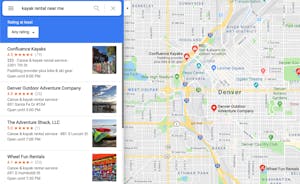
When you perform a search for local businesses near your location on Google Maps, it pulls data from Business Profile to display your location on the map and provide directions to your business, hours of operation, and contact information. Once again, appearing on this search is especially helpful for the travel industry, as visitors to your city might be doing quick searches on their phone and looking to book as soon as possible.
Google is constantly adding new features to make it more robust and collect more data. In addition to the information you add to your profile, Google can pull reviews, photos, and other information from other sources. This is why it’s important to keep your Google Business Profile updated and ensure it has all the information you want your customers to find. Here are some of the most important features you should be managing.
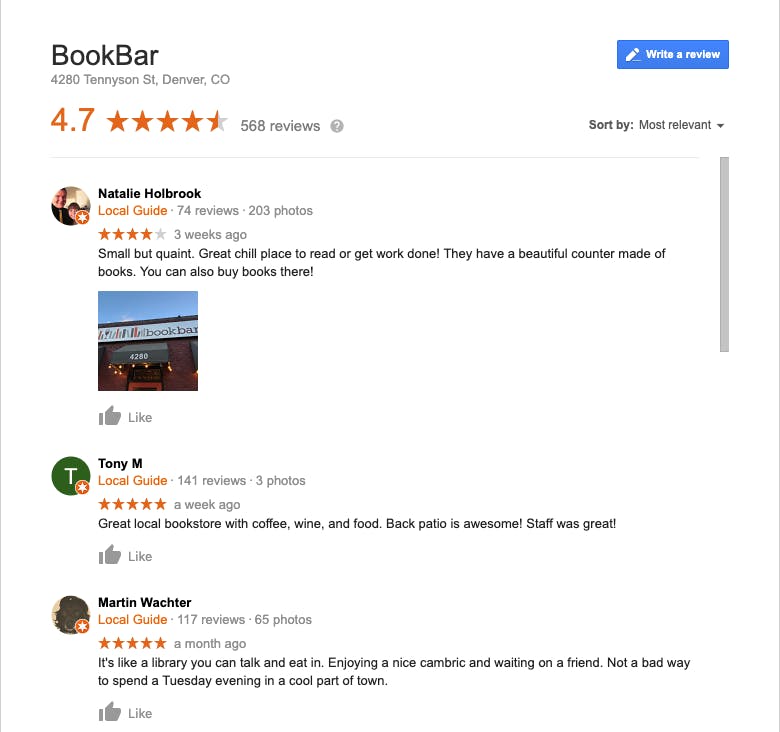
This is one of the key features of Google Business Profile, and it’s one that can have a huge impact on your business. According to BrightLocal, businesses that appear in the top three of the Local Map Pack have an average of 47 Google Reviews.
To give you an idea of the importance of reviews:
Having your reviews readily available on Google Business Profile helps potential customers see the value of your company and encourages them to book with you.
Reviews not only provide social proof, but they can also help you rank and improve your clickthrough rates. To get the most out of Google Reviews, it’s important to manage them, responding to both positive and, more importantly, negative reviews. You can learn more about this on our guide to managing your reviews.
 As Google makes its platform more robust, searchers can often access much of the information they are looking for right off the search engine without having to click through to a website. As of June 2019, 50% of Google searches result in zero clicks, meaning users don’t click through to a website after conducting a search query (SparkToro). That can be scary for business owners who have put a lot of effort into their website, but this is why it’s important to get as much information in front of potential customers right there in the SERP. To this end, you can use Google Posts to promote offers, events, and services right in the Knowledge Graph.
As Google makes its platform more robust, searchers can often access much of the information they are looking for right off the search engine without having to click through to a website. As of June 2019, 50% of Google searches result in zero clicks, meaning users don’t click through to a website after conducting a search query (SparkToro). That can be scary for business owners who have put a lot of effort into their website, but this is why it’s important to get as much information in front of potential customers right there in the SERP. To this end, you can use Google Posts to promote offers, events, and services right in the Knowledge Graph.
There are four types of Google Posts: Product, What’s New, Event, and Offer. When creating a Google Post, you can include copy, images, a link to a landing page, and a button with a CTA. Posts are ideal for brief announcements, such as a special offer for the weekend or seasonal promotions, and are a great chance to add some keywords and images to your Knowledge Graph. This feature allows you to speak directly to your customer and show them that you are an engaged business with a great online presence.
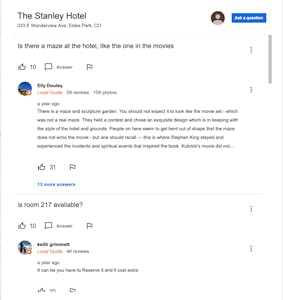
Similar to the Q&A feature you might see on Amazon or other e-commerce sites, Google Q&A allows customers to ask and answer questions about your business. This is a crowd-sourced feature, meaning anyone can ask or answer questions. There are benefits and downfalls to crowd-sourced information, mostly because someone may respond to a question about your business differently than you would have responded, and that can be frustrating. Keep in mind you have the opportunity to ask and answer questions as well and to get the correct information out there.
Google Q&A can help potential customers make a final decision about booking with your business. They might scan the questions to see if anyone has asked whether you offer family-friendly activities or how long your tours are. Users can react to common or helpful questions and answers with a thumbs up, which moves them closer to the top.
 Pro tip: Make the most of this feature by adding questions and answers yourself. Think about the questions you get on the phone often — anything that can help the customer make a decision about booking with you — and add them to the Q&A.
Pro tip: Make the most of this feature by adding questions and answers yourself. Think about the questions you get on the phone often — anything that can help the customer make a decision about booking with you — and add them to the Q&A.
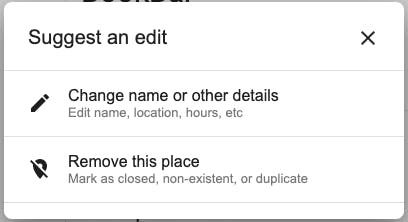
This feature allows users to suggest an edit to your profile. For example, if your business hours say you’re open until 6 p.m., but a customer stopped by at 5:15 p.m. and you were already closed, they can suggest that you update the hours of operation to reflect your current hours. Users can also suggest changes to your business name, location, and other information, or even suggest that it be marked as closed, non-existent, or duplicate.
Ideally, you are staying on top of your Google Business Profile and updating all your information as needed, but in case something slips through the cracks, users can let you know. The primary owner of a Google Business Profile receives an email notification when edits are suggested.
 Pro tip: Check your account often to ensure no incorrect edits have been made and that all your information is accurate.
Pro tip: Check your account often to ensure no incorrect edits have been made and that all your information is accurate.
Now that you’re well versed in everything Google Business Profile has to offer, you’re ready to claim your account. But how do you know if you qualify for a listing in the first place? These are the types of businesses that qualify:
Basically, if you interact with customers during your business hours, you qualify for a Google Business Profile. (Online-only, eCommerce, rental properties, and other types of businesses that don’t have in-person interaction don’t qualify.) It’s important to note that, to verify and manage your business information on Google Business Profile, you must be the business owner or an authorized representative. Once you have claimed your business, you can designate managers who are allowed to edit your information.
Now that you’ve learned about the different features of Google Business Profile and how it can help your business, it’s time to put that knowledge to work and start enjoying the benefits of this free and easy tool. Head to our guide on how to set up and optimize your Google Business Profile to get started!